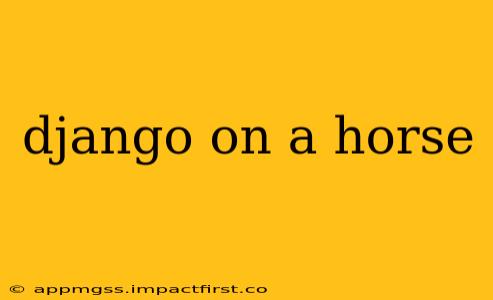The phrase "Django on a horse" might seem absurd at first glance. What could possibly connect the elegant Python-based web framework, Django, with equestrian pursuits? Surprisingly, the analogy holds more merit than you might think, offering a unique perspective on the power and flexibility of Django in building robust web applications. Let's explore this unexpected connection.
What Does Django Do?
Before we dive into the horse analogy, let's quickly establish what Django is. Django is a high-level Python web framework known for its "batteries-included" philosophy. This means it provides a comprehensive suite of tools and features right out of the box, making it significantly faster to develop web applications compared to starting from scratch. Think of it as a pre-assembled, highly customizable toolkit for building complex websites and web applications.
Django as the Rider, the Horse as the Web Application
Now, let's consider the analogy:
-
Django is the skilled rider: The rider possesses the knowledge, skill, and experience to control and guide the horse effectively. Similarly, Django developers leverage the framework's capabilities to build, manage, and maintain complex web applications with efficiency and precision. They utilize Django's features like its Object-Relational Mapper (ORM) for database interaction, its templating engine for dynamic content generation, and its robust security features to create secure and scalable applications.
-
The horse is the web application: The horse represents the final product – a powerful and versatile tool capable of carrying a significant load and traversing diverse terrains. The web application, built using Django, can be simple or complex, depending on the requirements. It could be a small blog, a large e-commerce platform, or a sophisticated data-driven application. Just as a horse can be trained for specific tasks, a Django application can be tailored to meet precise user needs.
Understanding the Analogy's Nuances:
This analogy isn't about literal horses and riders; instead, it highlights several key aspects of Django:
-
Control and Guidance: Just as a rider guides the horse, Django empowers developers to direct the development process, ensuring the application aligns with specifications and requirements.
-
Power and Flexibility: A well-trained horse can navigate challenging terrain. Similarly, Django's flexibility allows developers to build various applications, from simple to highly complex, adapting to evolving project needs.
-
Efficiency and Speed: An experienced rider can accomplish much more than a novice. Django's streamlined workflow, built-in features, and vast community support enable developers to build applications efficiently.
Frequently Asked Questions:
Is Django suitable for beginners?
While Django offers a wealth of features, it's also well-documented and has a large, supportive community, making it suitable for beginners willing to invest time in learning. Many tutorials and resources cater specifically to novice developers.
How does Django compare to other web frameworks?
Django stands out due to its "batteries-included" approach, offering extensive features out of the box. Other frameworks might require more manual configuration. The best choice depends on the specific project requirements and the developer's experience.
What kind of applications can I build with Django?
The possibilities are vast. Django is used to build everything from content management systems (CMS) and e-commerce platforms to social networks and data-driven applications.
Is Django secure?
Django has robust security features built-in, including protection against common web vulnerabilities such as SQL injection and cross-site scripting (XSS). However, secure development practices are crucial, regardless of the framework used.
In conclusion, while "Django on a horse" might seem unusual, the analogy provides a unique and memorable way to understand the power and flexibility of this versatile web framework. It's not just about writing code; it's about skillfully guiding the creation of robust and efficient web applications.
